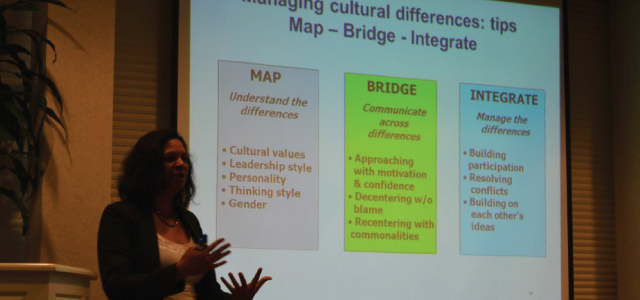Cultural Differences and Challenges in Cross-cultural Communication
Magdalene Cooman, Director of Employer Engagement from World Skills Employment Centre, delivered the cross-cultural training session at the TD VISMIN-WORLD SKILLS Mentorship Program launch event. Her presentation focused on an introduction to culture and cultural differences, challenges in cross cultural communication, and understanding cultures through one of the culture modes by Hofestede. Through the interactive dialogue with the audience, several key messages were highlighted:
- We all want to feel belonged and accepted. When we do not feel belonged, it causes conflict which makes one think of ‘how to escape’ from a particular place or situation.
- Various countries have various styles of communications. However, t is important not to stereotype individuals because personality and environment can have an impact on culture. For example, a typical stereotype is that Germans are rigid, methodical, obsessed with order & privacy, unemotional and territorial but this may not be the case with all Germans.
- Culture, as defined by G. Hofstede equals human mental programing, which helps us to appreciate that some elements of culture are universal, some are specific to a group and some are specific to an individual. Culture can be inherited and/or learned. The nature of culture is that it is learned through experience; it is shared by members of a group or society and it is also transgenerational and can be passed from one generation to another.
Embracing diversity in the workplace
In Canada, progressive leaders recognize the importance of diversity and cultural integration as key elements to build successful businesses. The demographics are changing and the projections are that immigrants will be replacing the retiring workforce. Although each business has its own organizational culture, it is becoming more and more important for business leaders like TD to step up and grab the opportunity to embrace diversity in the workplace. If done correctly, diverse teams can add innovative solutions and help businesses to gain a competitive advantage. For cultural integration to happen smoothly, it is recommended that the following steps be taken into consideration:
- Map: Understand the differences. The differences may be in cultural values, leadership style, personality, thinking style or gender
- Bridge: Communicate across differences by approaching situations with motivation and confidence, decentering without blame and re-centering with commonalities
- Integrate: Manage the differences by building participation, resolving conflict and building on each other’s ideas
If you are interested in exploring how cross cultural communications training can add value to your workplace, please contact Magdalene@ottawa-worldskills.org.




